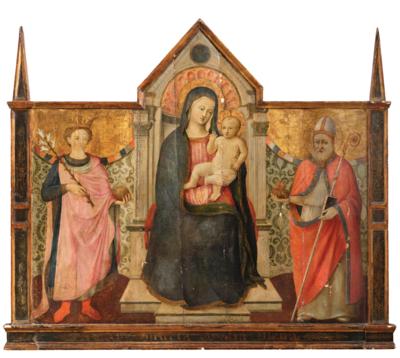Attributed to Andrea Manzini, called Andrea di Giusto
(Florence circa 1400–1450)
Madonna and Child enthroned, with Saint Louis (?) and Saint Nicholas,
tempera and gold on panel, overall 153 x 174 cm, integral frame
Provenance:
Private European collection
Andrea Manzini, also known as Andrea di Giusto, was probably born in Florence around the turn of the fourteenth and fifteenth centuries. The archives of the Ospedale di Santa Maria Nuova document the artist’s apprenticeship in Bicci di Lorenzo’s workshop in the 1420s, together with lo Scheggia, Masaccio’s brother. In 1424 Manzini’s name appears for the first time in the lists of the Compagnia di San Luca, the guild of Florentine painters, where he is mentioned until 1447.
Between 1426 and 1427 Andrea di Giusto worked with Masaccio, but at present little is known of this period. His first certain work is a polyptych with the Madonna and Saints, now in the Palazzo Pretorio, Prato, commissioned in 1428 and finished in 1435 for the convent of San Bartolomeo delle Sacca, reflecting the influence of Lorenzo Monaco and Beato Angelico (see G. Giura, Due polittici per un altare? Lorenzo Monaco e Andrea di Giusto per gli Olivetani di San Bartolomeo delle Sacca, in: P. Benassai (ed.), Officina pratese, Florence, 2014, pp. 229–244).
In later compositions the artist shows awareness of Masaccio’s work, for example in the Madonna and Child with Angels in the Stibbert Museum, Florence which refers to the Sant’Anna Metterza by Masolino and Masaccio. In particular the position of the Child’s legs and in the arrangement of the angels around the throne (see L. Berti, A. Paolucci (eds.), L’età di Masaccio. Il primo Quattrocento a Firenze, exhibition catalogue, Milan 1990, p. 198). The present triptych which appears to still retain its original format, is inspired by the traditional structure of late Gothic polyptychs. The Madonna and saints are depicted in a single space, consisting of the Madonna’s throne and two sides decorated with "velari".
The figure on the left probably represents Saint Louis, King of France who died in 1270, as he wears the crown and globe of monarchical power. Saint Nicholas can be identified on the right, with his attributes of the bishop’s mitre and staff as well as the three golden coins in his hand. A similar arrangement was adopted by Andrea Manzini in the signed and 1437 dated Madonna of the Girdle in the Gallerie dell’Accademia, Florence (inv. 1890 no. 3236). Especially the facial features, characterised by a refined late Gothic grace, are comparable.
Esperto: Mark MacDonnell
 Mark MacDonnell
Mark MacDonnell
+43 1 515 60 403
oldmasters@dorotheum.com
24.04.2024 - 18:00
- Prezzo realizzato: **
-
EUR 104.000,-
- Stima:
-
EUR 80.000,- a EUR 120.000,-
Attributed to Andrea Manzini, called Andrea di Giusto
(Florence circa 1400–1450)
Madonna and Child enthroned, with Saint Louis (?) and Saint Nicholas,
tempera and gold on panel, overall 153 x 174 cm, integral frame
Provenance:
Private European collection
Andrea Manzini, also known as Andrea di Giusto, was probably born in Florence around the turn of the fourteenth and fifteenth centuries. The archives of the Ospedale di Santa Maria Nuova document the artist’s apprenticeship in Bicci di Lorenzo’s workshop in the 1420s, together with lo Scheggia, Masaccio’s brother. In 1424 Manzini’s name appears for the first time in the lists of the Compagnia di San Luca, the guild of Florentine painters, where he is mentioned until 1447.
Between 1426 and 1427 Andrea di Giusto worked with Masaccio, but at present little is known of this period. His first certain work is a polyptych with the Madonna and Saints, now in the Palazzo Pretorio, Prato, commissioned in 1428 and finished in 1435 for the convent of San Bartolomeo delle Sacca, reflecting the influence of Lorenzo Monaco and Beato Angelico (see G. Giura, Due polittici per un altare? Lorenzo Monaco e Andrea di Giusto per gli Olivetani di San Bartolomeo delle Sacca, in: P. Benassai (ed.), Officina pratese, Florence, 2014, pp. 229–244).
In later compositions the artist shows awareness of Masaccio’s work, for example in the Madonna and Child with Angels in the Stibbert Museum, Florence which refers to the Sant’Anna Metterza by Masolino and Masaccio. In particular the position of the Child’s legs and in the arrangement of the angels around the throne (see L. Berti, A. Paolucci (eds.), L’età di Masaccio. Il primo Quattrocento a Firenze, exhibition catalogue, Milan 1990, p. 198). The present triptych which appears to still retain its original format, is inspired by the traditional structure of late Gothic polyptychs. The Madonna and saints are depicted in a single space, consisting of the Madonna’s throne and two sides decorated with "velari".
The figure on the left probably represents Saint Louis, King of France who died in 1270, as he wears the crown and globe of monarchical power. Saint Nicholas can be identified on the right, with his attributes of the bishop’s mitre and staff as well as the three golden coins in his hand. A similar arrangement was adopted by Andrea Manzini in the signed and 1437 dated Madonna of the Girdle in the Gallerie dell’Accademia, Florence (inv. 1890 no. 3236). Especially the facial features, characterised by a refined late Gothic grace, are comparable.
Esperto: Mark MacDonnell
 Mark MacDonnell
Mark MacDonnell
+43 1 515 60 403
oldmasters@dorotheum.com
|
Hotline dell'acquirente
lun-ven: 10.00 - 17.00
old.masters@dorotheum.at +43 1 515 60 403 |
| Asta: | Dipinti antichi |
| Tipo d'asta: | Asta in sala con Live Bidding |
| Data: | 24.04.2024 - 18:00 |
| Luogo dell'asta: | Wien | Palais Dorotheum |
| Esposizione: | 13.04. - 24.04.2024 |
** Prezzo d'acquisto comprensivo di tassa di vendita e IVA
Non è più possibile effettuare un ordine di acquisto su Internet. L'asta è in preparazione o è già stata eseguita.

